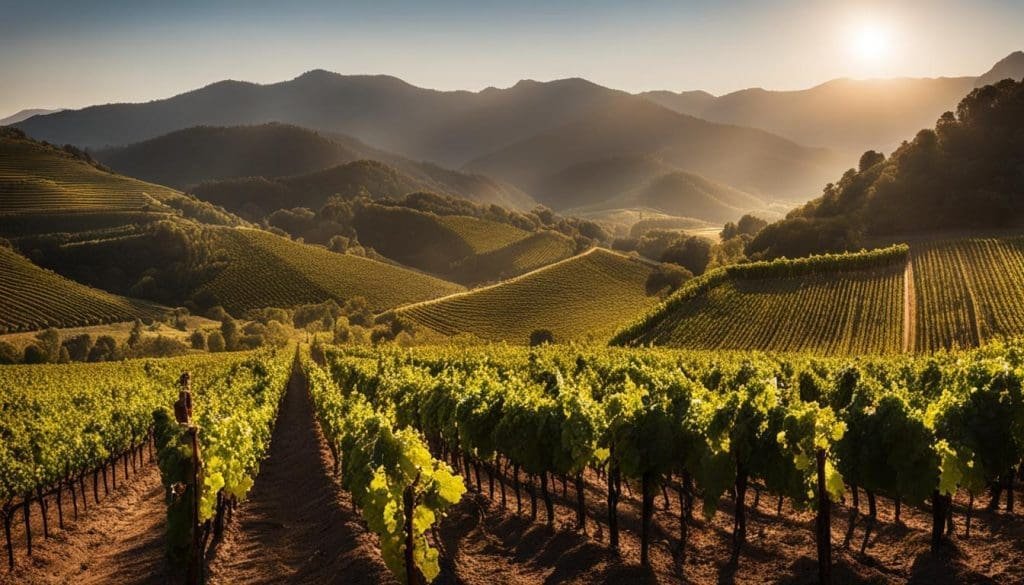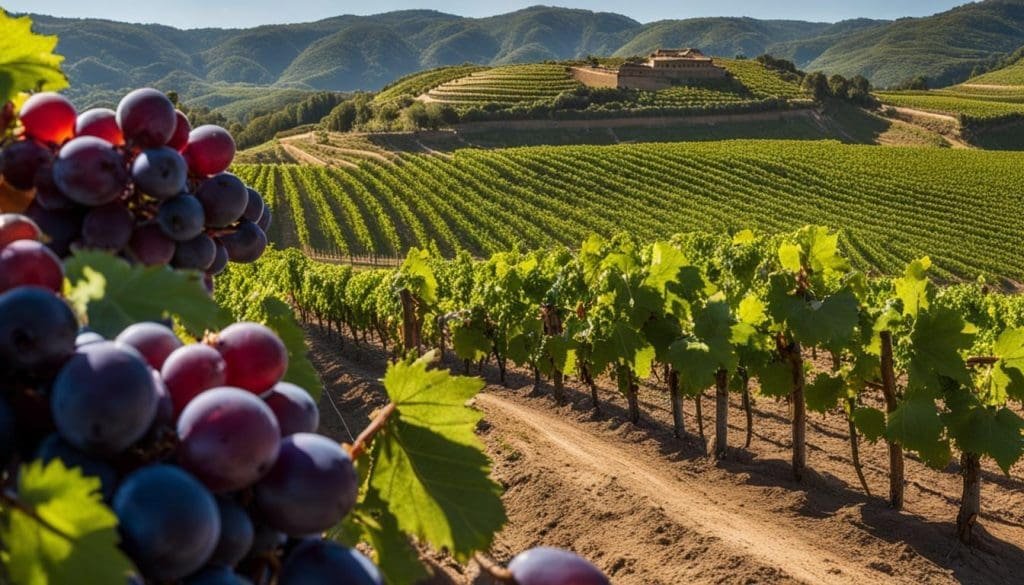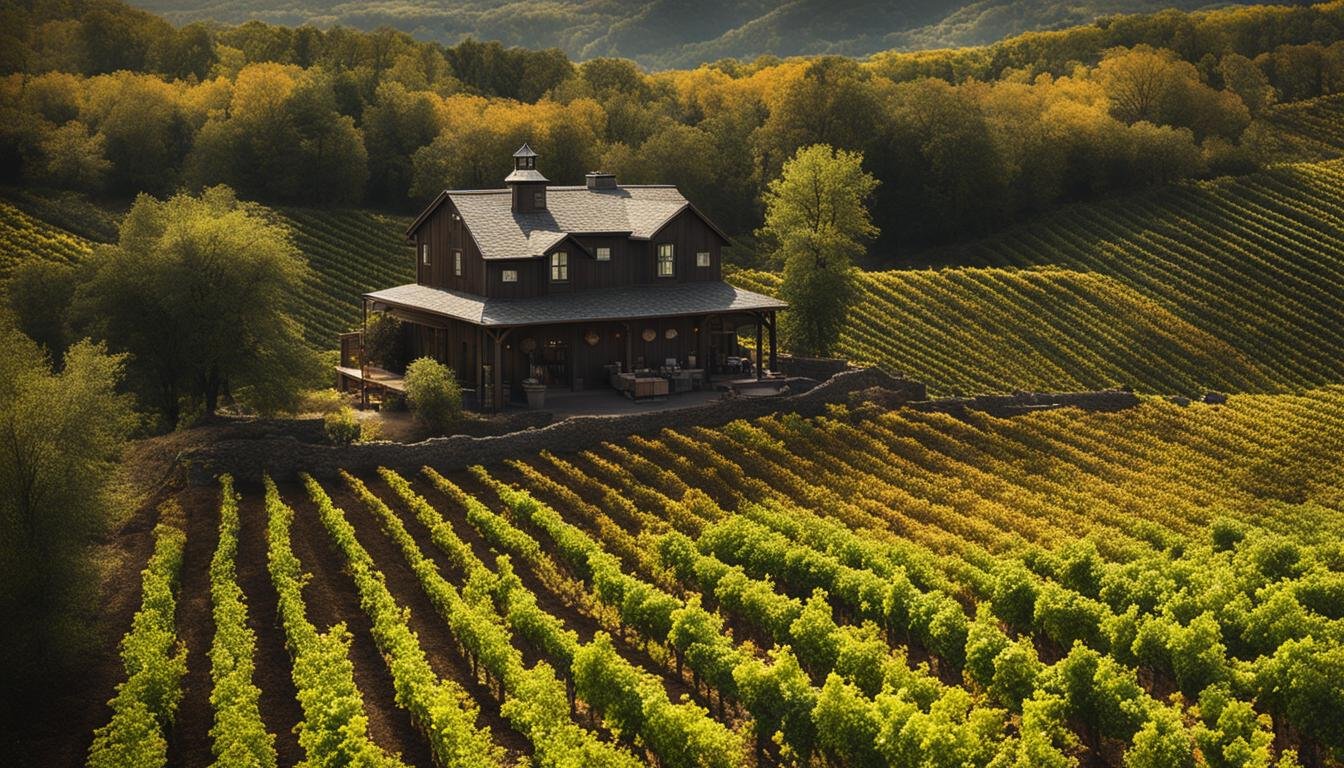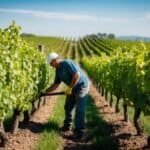This post may contain affiliate links. Please read my disclosure policy.
Terroir, a widely recognised yet enigmatic French term, embodies the distinctive characteristics of a wine that originate from its specific environmental factors. With roots embedded deep within the realms of viticulture, terroir is the fingerprint that makes each wine region and wine production one of a kind. Key components such as temperature, climate, soil composition, and topography all play a vital role in shaping a wine’s unique terroir, bringing forth its individualised sensory profile. Delving into the complexities of the grape’s genetic makeup and cultural practices, such as viticulture and winemaking techniques, further accentuates the wine’s singularity and solidifies our understanding and appreciation of the art of winemaking.
Key Takeaways
- Terroir is the French term that encompasses the unique environmental factors influencing a wine’s profile.
- Temperature, climate, soil composition, and topography are crucial components of terroir.
- Wine production is influenced by the grape’s genetic makeup and cultural practices.
- The concept of terroir highlights the individuality and non-replicability of each wine.
- An intricate dance of environmental factors gives every wine region its distinct terroir fingerprint.
Understanding Terroir: The Soul of Viticulture
Understanding terroir is essential to comprehending the heart and spirit of viticulture, that is, the science, art, and culture of wine production. Terroir is a holistic concept that encapsulates the unique environmental factors shaping a wine’s character. It involves the complex interplay of soil composition, climate, and microclimate, which together create a distinct fingerprint for each wine region and individual vineyard.
Terroir showcases the intricate and interdependent nature inherent in winegrowing, illustrating how even identical wines crafted from the same grape variety and using the same process may exhibit differences when grown in different terroirs. The nuances of terroir can be described as an elaborate dance of environmental influences – often mysterious and perpetually crucial to the taste and quality of wine.
“Terroir is to wine what soul is to man.”
To better appreciate the importance and impact of terroir on wine culture and the global wine industry, let’s delve into the environmental factors that contribute to its unique nature:
- Soil Composition
- Climate
- Microclimate
Soil Composition: The soil found within a vineyard predominantly influences viticulture and winemaking. Its composition offers vital nutrients and affects essential aspects, such as water retention and heat absorption. The soil’s porousness and chemical makeup impact the vine’s root system, grape development, and ultimately, the wine’s taste.
Climate: The climate of a wine region plays a critical role in shaping wine’s terroir. Temperature fluctuation, precipitation, sunlight hours, and the growing season’s length significantly influence grape ripening and sugar production levels. As a result, the wine’s acidity, body, and overall flavour profile are affected.
Microclimate: As the name suggests, a microclimate refers to localised atmospheric conditions distinctly unique from the broader climatic patterns of a region. Microclimates are influenced by factors like altitude, topography, and proximity to bodies of water. These conditions can vary significantly within a wine region or even a single vineyard, adding distinctive traits to each wine’s terroir.
Below is a table that compares the impact of environmental factors on the wine’s terroir from different wine regions:
| Wine Region | Soil Composition | Climate | Microclimate |
|---|---|---|---|
| Bordeaux, France | Gravel, clay, limestone, and sand | Maritime, moderate rainfall | Continental climate in some areas, oceanic influence |
| Napa Valley, USA | Volcanic, sedimentary, and alluvial soils | Mediterranean, long, warm, and dry growing season | Valley floor, hillsides, and mountainous areas, coastal influence |
| Barossa Valley, Australia | Sandy loam, red clay, and limestone | Mediterranean, hot and dry, low rainfall | Valley floor and elevated areas, cooling breezes from the Southern Ocean |
In conclusion, understanding terroir is paramount to appreciating the complexities and individualities of wine culture and the wine industry as a whole. The intermingling of environmental factors, such as soil composition, climate, and microclimate, shapes the terroir and, subsequently, the character and quality of the wine itself. As we discover and analyse the rich tapestry of elements influencing wine’s terroir, our enjoyment and connection to viticulture and winemaking grow ever deeper.
The Components of Terroir: Soil, Climate and Topography
The components of terroir are the building blocks that contribute collectively to the expression and depth of a wine’s profile. Soil offers crucial nutrients and affects drainage and heat absorption, while climate contributes to grape sugar production and the threat of vine diseases or frost. Topography, including slope and altitude, influences factors such as sunlight exposure and air drainage. These aspects of terroir alter the grapes’ growth cycle and flavour development, laying the foundation for wine that is a true reflection of its origin.
- Soil Composition
- Climate Impact on Wine
- Vineyard Topography
These components have direct and indirect effects on the grapes and their ripening process, eventually shaping the overall wine profile. Next, we will delve into each of these factors in more detail.
Soil Composition
Soil composition in a vineyard has a significant influence on the wine’s flavour and structure, as it determines the availability of essential nutrients like nitrogen, phosphorus, and potassium. Different soil types can also impact drainage, heat absorption, and water-holding capacity, ultimately affecting how the vines grow and the grapes develop.
The soil is to wine as the stage is to theatre; it sets the foundation for the performance and provides a unique personality to each production.
Common soil types found in vineyards include limestone, clay, sand, and volcanic soils. Each soil type has its own properties and characteristics, which contribute to the distinct profile of wines produced from them.
Climate Impact on Wine
Climate has a multifaceted effect on the vineyard environment, ranging from grape sugar production to the type and intensity of diseases that may threaten the vines. Warmer climates encourage a quicker grape ripening process, while cooler climates can prolong the ripening and lead to higher acidity and more restrained fruit flavours. Vineyards also need to adapt to climatic changes such as temperature fluctuations, frost, and extreme weather events, which can put pressure on both vines and winemakers.
Vineyard Topography
Varying topography across a vineyard can result in unique microclimates, thus affecting sunlight exposure, air drainage, and soil depth for different vine plots. Slope and altitude are two key topographical factors that have direct consequences on vine growth and grape ripening:
| Factor | Effect on Vines |
|---|---|
| Slope | Steeper slopes can increase sunlight exposure and improve air circulation, helping to reduce the risk of disease. |
| Altitude | Higher altitude vineyards experience cooler temperatures, which can slow grape ripening and impact the grapes’ sugar and acidity levels. |
Understanding the intricate dance between soil composition, climate impact, and vineyard topography is essential for appreciating the unique character and complexity of terroir-driven wines.
The Terroir Fingerprint: How Winemaking Regions Differ
The uniqueness of each wine region is attributed to the varying terroir, which manifests through countless characteristics that play a vital role in influencing the final outcome of wine. These distinctive elements include the impact of elevation and slope, the presence of bodies of water, and the dichotomy between old world and new world winemaking traditions.
Impact of Elevation and Slope on Vineyard Character
Elevation and slope are essential factors that determine the character of a vineyard. Higher altitude vineyards often experience lower temperatures, which contributes to slower grape ripening and the development of complex flavors. The slope of the vineyard influences sunlight exposure and air circulation, subsequently affecting the grape’s growth cycle and flavor development. These factors, in turn, contribute to the elevation impact on wine and its final taste profile.
Water’s Influence: Proximity to Lakes and Oceans
Bodies of water significantly influence wine regions, as they often provide a moderating effect on climate. Proximity to lakes or oceans can create a more tempered climate, reducing extreme temperature fluctuations and promoting a longer growing season. This unique bodies of water influence results in wines with exceptional balance between acidity and sugar content.
Old World vs New World: Tradition Meets Innovation
The contrasting winemaking traditions found in old world and new world regions create a diverse landscape of flavors, techniques, and expressions. Old world viticulture regions are characterized by centuries-old winemaking practices and a strong emphasis on terroir, whereas new world regions often embrace experimental techniques and innovative approaches. The preferences of each region’s grape growers and winemakers ultimately shape the final product, adding another layer of interest to the wide array of wines available to enthusiasts.
“Wine is the most healthful and most hygienic of beverages.” – Louis Pasteur
As shown in the table below, a comparison of winemaking regions illustrates the varying factors that contribute to a wine’s unique terroir and the styles they produce:
| Winemaking Region | Elevation and Slope | Proximity to Bodies of Water | Winemaking Traditions | Typical Wine Styles |
|---|---|---|---|---|
| Bordeaux, France | Low altitude, gentle slopes | Proximity to Atlantic Ocean and Gironde Estuary | Old world | Full-bodied reds with high tannins, acidity, and oak influence |
| Napa Valley, USA | Varied elevation and slopes | Proximity to San Pablo Bay and Pacific Ocean | New world | Big, fruit-forward wines with rich flavors and higher alcohol |
| Barossa Valley, Australia | 250 to 500 meters above sea level | 80 kilometers from Gulf of St Vincent | Combination of old and new world approaches | Full-bodied, bold Shiraz with dark fruit, pepper, and spice notes |
Ultimately, it is the unique combination of these elements within each wine region that stands as a testament to the versatility and depth found within the world of wine.
Microclimate and Its Subtle Effects on Wine’s Profile
Microclimates present subtle yet pivotal deviations in climate, even within the same broader wine regions or specific vineyards. These localised atmospheric conditions, from temperature to wind patterns, play a crucial role in fine-tuning the grape varieties’ expression and wine’s sensory characteristics – helping to craft a profile imbued with the distinctive traits of its specific locale. As we delve deeper into the microclimate influence on wine profile, we realise that to truly appreciate and understand the uniqueness of terroir in wine production, it is essential to recognise the significance and interplay of these subtle climatic fluctuations.

While larger wine regions may have overarching climates and geographic characteristics, it is often the smaller sub-regions or even individual vineyards that display the most unique identities in their wines. Factors such as the diurnal temperature range, the aspect of a slope, and the level of humidity or precipitation all shape the eventual wine profile, painting a vivid picture of its origin.
In this sense, the influence of microclimate on a wine’s profile can be akin to a fingerprint, leaving its marks on the final product and revealing those subtle nuances of terroir that make it memorable and distinctive. Let’s take a closer look at some examples of how microclimate variations can impact wines in smaller wine regions and specific vineyards:
“A good vigneron can almost taste the microclimate in the wine.”
- Diurnal Temperature Range: The difference between the warm daytime and cool nighttime temperatures can have a profound impact on the ripening process, flavor development, and acidity of the grapes, resulting in a more balanced and expressive wine.
- Aspect of a Slope: Vineyards situated on different slopes may experience varying levels of sunlight exposure, affecting factors such as photosynthesis, grape ripening, and sugar development. These differences can ultimately shape the wine’s flavor profile and its overall balance.
- Humidity and Precipitation: When looking at climate vs terroir, we must consider the humidity and precipitation levels in a specific locale. These factors can impact grape development and the threat of vine diseases, which in turn influence the wine’s characteristics and quality.
In conclusion, the microclimate’s influence on a wine’s profile is a crucial factor in the manifestation of the unique identity of wines. By recognising and understanding the various elements of microclimate and their impact, we can fully appreciate the intricate relationship between climate, terroir, and the distinctive qualities of our favorite wines.
Soil Types and Wine Structure: A Dynamic Relationship
The dynamic relationship between terroir and wine is influenced significantly by the soil types in which the grapes are grown. Soil composition plays a pivotal role in determining the grapevine’s capacity to absorb water and nutrients, ultimately impacting the wine structure, or the overall sensory profile – including aroma, taste, and mouthfeel. This section delves into the unique characteristics of calcareous and volcanic soils, exploring their influence on creating distinctive terroir expressions in wines.
Calcareous Clarity: How Limestone Forms Great Terroir
Calcareous soil, which predominantly consists of limestone, is highly prized in the wine industry for its ability to create distinctive, terroir-driven wines. Limestone is known for its excellent drainage capabilities, fostering roots to grow deep into the soil in search of water and nutrients. This characteristic encourages a more concentrated and complex grape profile, resulting in wines with enhanced aromatics, minerality, and acidity.
“Limestone in the soil is like the soul of a great wine; it is that magical element that imparts terroir to a wine, giving it an unmistakable sense of place.”
Some of the world’s most renowned wine regions, such as Burgundy and Champagne in France, boast calcareous soils, which contribute to the land’s celebrated terroir. The following table highlights key aspects of the soil types and their impact on the wine structure in these regions:
| Wine Region | Grape Varieties Grown | Notable Impact on Wine Structure |
|---|---|---|
| Burgundy, France | Pinot Noir, Chardonnay | High minerality, balanced acidity, pronounced aromatics |
| Champagne, France | Pinot Noir, Chardonnay, Pinot Meunier | Bright acidity, finesse, elegant texture |
Volcanic Vigour: The Depth Added by Igneous Soils
Volcanic soil benefits wines with pronounced depth, intensity, and complexity of flavours. These soils, formed from cooling lava and volcanic ash, are rich in minerals, contributing to the health and vigour of the vines. One unique attribute of volcanic soils is their capacity to hold onto water, allowing for a more consistent supply to the vines throughout the growing season. This helps to establish a balanced maturation process, ultimately resulting in wine with complexity and character.
- Mineral Richness: The abundance of minerals ensures healthy, robust grapevines, translating to wines with pronounced flavours and a persistent mineral presence on the palate.
- Superior Water Retention: The vine roots benefit from consistent moisture levels, enabling them to extract nutrients more efficiently, leading to even grape ripening and, consequently, nuanced and elegant wine.
- Distinctive Terroir Expression: The unique properties of volcanic soil encourage the development of an authentic and distinguishable terroir, offering a genuinely compelling wine experience.
Some iconic wine regions featuring igneous soils are the Douro Valley in Portugal and Santorini in Greece. These regions are home to wines with unparalleled intensity, complexity, and longevity – a testament to the significant impact of soil types on terroir and, ultimately, the final character of the wine.
The Human Touch: Winemaking Techniques and Terroir
The human touch in winemaking techniques adds another dimension to terroir, as centuries-old practices and modern winemaking innovation intersect to shape the final character of the wine. Whether it’s the method of vine training, the choice of fermentation vessels, or the decision to dry harvest grapes, winemakers’ decisions are deeply intertwined with terroir, reflecting both the region’s heritage and its contemporary evolution.

Winemaking techniques differ vastly across the globe, reflecting the deep-rooted traditions of each wine region. Some opting for centuries-old practices, while others embrace cutting-edge innovation in their approach towards viticulture. These choices, whether focused on the vine, the grape or even the barrel, all contribute to the unique expression of terroir in each bottle of wine.
“The work of the winemaker is vital. They have to carefully observe, understand and make decisions in a timely and sensitive manner.”
– Angelo Gaja, Italian Winemaker
Let’s delve deeper into the impactful role **winemakers** play in shaping terroir and how their choices are ingrained in regional heritage:
- Vine Training and Canopy Management: The way vines are trained and pruned can dramatically alter the exposure of grapes to sunlight, ultimately impacting their growth, ripening, and flavour profile.
- Fermentation Vessels: The choice between traditional oak barrels, steel tanks, or even clay amphorae can bring forth vastly different accents and subtleties in flavour and texture, reflecting a region’s ethos and philosophy towards winemaking.
- Harvesting Techniques: One such method, the decision to dry harvest grapes, can impact the resulting wine’s sugar and flavour concentration – shaping the unmistakable characteristics of wines like Amarone from Valpolicella, Italy.
It’s not only traditional techniques that showcase the **human influence on terroir** but also the touch of modernity; as the world of wine progresses, so do the techniques used in winemaking. Advances in technology, such as precision viticulture and innovative fermentation methods, help finetune the expression of terroir, allowing winemakers greater control over the final product without losing the essence of the region.
| Traditional Technique | Modern Technique | Impact on Terroir |
|---|---|---|
| Punching down grapes | Automated pump over | Controlling extraction and quality |
| Aging in oak barrels | Aging in stainless steel, glass or concrete | Altering the flavor and texture |
| Manual sorting of grapes | Use of optical sorters | Ensuring consistency and quality |
In the ever-evolving world of wine, the human touch remains an integral ingredient in reflecting and enhancing terroir. From the foundations of traditional **wine region traditions** to the exciting advancements of **modern winemaking**, winemakers’ decisions shape and define the unique expression of terroir found in each bottle.
Climate Change and Shifting Terroirs: Adaptation in the Vineyard
The impact of climate change on the wine industry is causing a shift in traditional terroirs, necessitating creative vineyard adaptation strategies. As weather patterns change and natural conditions become more extreme, winemakers and viticulturists are faced with the challenge of maintaining both the quality and the individuality of their wines that are so heavily influenced by their terroir. Some vineyards are already experiencing the effects of shifting terroirs, with changes in grape varieties and wine styles becoming necessary. In response, the wine industry is evolving and looking to new viticulture offerings to secure their future success.
Vineyard adaptation is a multifaceted approach involving a combination of alterations in grape varieties, vine orientations, and innovative irrigation techniques. Each strategy works to combat the effects of climate change on terroirs, safeguarding the unique identity of wines and proving that the wine industry is adaptable and resilient in the face of adversity.
“The changing climate demands a proactive and innovative approach, as our cherished terroirs may no longer produce the wine styles we are accustomed to. We must embrace new techniques and grape varieties to thrive in an ever-evolving industry.”
Notable adaptation strategies include:
- Exploring alternative grape varieties
- Altering vineyard row orientation
- Adjusting vine training systems
- Implementing cover cropping and other soil management techniques
- Introducing innovative irrigation methods
One key adaptation strategy is the exploration of new grape varieties that are better suited to the changing climate conditions. By selecting grape varieties that are more resistant to heat, drought, and disease, winemakers can continue to produce exceptional wines despite the evolving climate.
| New Grape Varieties | Attributes | Regions Adapting |
|---|---|---|
| Touriga Nacional | Drought-resistant, high sugar content | Spain, France |
| Nero d’Avola | Heat-tolerant, low acidity | Australia, California |
| Assyrtiko | Drought-tolerant, high acidity | Greece, Australia |
By embracing these adaptation strategies and a broader spectrum of grape varieties, the wine industry can navigate the uncertain landscape of climate change and shifting terroirs, striving to preserve the unique expressions of terroir in winemaking. By doing so, winemakers and viticulturists will continue to create exceptional wines that embody the character of their origins, even as those origins evolve with the world around them.
Conclusion: The Ever-Evolving Narrative of Terroir in Winemaking
The evolving narrative of terroir in winemaking is a tale of constant adaptation, encompassing shifts in the environment, breakthroughs in viticulture methods, and the changing preferences of wine enthusiasts. The importance of terroir in viticulture is reflected in its role as the central thread connecting a bottle of wine with its origin, embedding the unique terroir characteristics of geography, climate, and essence into each drop.
As winemakers continue their terroir exploration, discovering new ways to express the distinct identity of their vineyards and regions, the story of terroir becomes ever more dynamic and diverse. From traditional techniques to innovative practices, these approaches to winemaking reflect the symbiotic relationship between a wine’s quality and its terroir – shaping a distinct narrative that emerges from the elemental language of the land.
As we look to the future, the concept of terroir reminds us to celebrate the remarkable connections between wine, the landscape, and the people behind its creation. As terroir shifts and adapts to the ever-changing world around us, the story of wine will continue to evolve – ensuring that each sip offers a unique and timeless connection to the rich tapestry of life within the vineyard.
FAQ
What is terroir and why is it important in wine production?
Terroir is a French term with no official definition, yet it is widely understood among wine enthusiasts as the sense of place and unique characteristics of wines influenced by specific environmental factors. These factors include temperature, climate, soil composition, and topography. Terroir is essential in wine production, as it greatly impacts attributes such as acidity, sugar levels, body, and overall flavour profile, creating a wine that is unique and non-replicable.
How does soil composition affect terroir?
Soil composition plays a significant role in terroir, as it provides crucial nutrients to the vines, affects drainage, and influences heat absorption. Different soil types have varying characteristics that impact the growth cycle and flavour development of grapes, resulting in a wine that truly reflects its origin.
What is the difference between climate and microclimate in terms of terroir?
Climate refers to the general atmospheric conditions of a wine region, while microclimate refers to the subtle, localised deviations in climate, even within the same broader region or specific vineyard. Microclimates can greatly impact the expression of grape varieties and wine’s sensory characteristics, adding distinctive traits from their specific locale to the final product.
How do winemaking techniques contribute to terroir?
The human touch in winemaking techniques adds another dimension to terroir, as both traditional practices and modern innovations shape the final character of the wine. Choices like vine training methods, fermentation vessels, or grape processing can deeply intertwine with terroir, reflecting both the region’s heritage and its contemporary progress.
What challenges and opportunities does climate change pose to terroir?
Climate change induces shifts in weather patterns, prompting adaptations strategies in vineyards worldwide. Such strategies may include altering grape varietals, modifying vine orientations, or innovating irrigation techniques. These actions may redefine regional identities and expand the spectrum of terroir, creating both challenges and opportunities for the wine industry.
User Review
( votes)Sip smarter, subscribe now!
Subscribe for gourmet tips, event updates, travel ideas, and a free e-book on Food Pairings. Start your journey to culinary and travel excellence!













